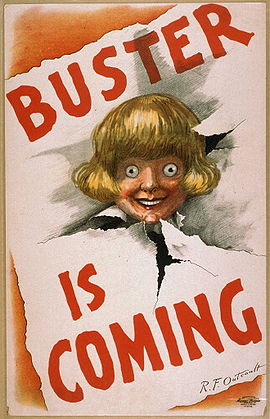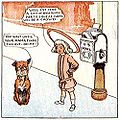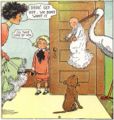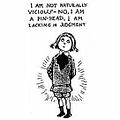- Buster Brown
-
For other uses, see Buster Brown (disambiguation).
Buster Brown was a comic strip character created in 1902 by Richard Felton Outcault which was known for his association with the Brown Shoe Company. (The name "Buster" came either directly or indirectly from the popularity of Buster Keaton, then a child actor in vaudeville.)[1]
This mischievous young boy was loosely based on a boy near Outcault's home in Flushing, New York. His physical appearance, including the pageboy haircut, was utilized by Outcault and later adopted by Buster Brown. The actual boy's name was Granville Hamilton Fisher, son of Charles and Anna Fisher of Flushing. The family subsequently moved to Amityville, New York where Charles Fisher ran a real estate and insurance business on Merrick Road. Granville operated a phonograph and radio sales and repair shop across the street from his father until his sudden death in 1936.
Richard Barker played Buster Brown in the Brown Shoe Company advertising campaign as a small child. There is a book written about Richard Barker and his life as Buster Brown in the advertising campaign. The book about Richard Barker is titled “Buster Brown and the Cowboy”.
Contents
Characters and story
Buster Brown, his sister Mary Jane, and his dog Tige, an American Pit Bull Terrier, were well known to the American public in the early 20th century. Tige is thought to be the first talking pet to appear in American comics, and, like that of many of his successors, his speech goes unnoticed by adults.
Buster Brown is a young city-dwelling boy with wealthy parents. He is disturbingly pretty (contrast him to The Yellow Kid, or Frederick Opper's creations), but his actions belie his looks. He is a practical joker who might dress in a girl's outfit and have her wear his clothes, break a window with his slingshot, or play a prank on a neighbor. The trick or transgression is discovered and he is punished, usually by being spanked by his mother, but it is unclear if he ever repents. Many strips end with Buster delivering a self-justifying moral which has little or nothing to do with his crime. For example, a strip from May 31, 1903, shows him giving Tige a soda from a drugstore soda fountain. The drink splashes, not only the front of his own clothes, but the skirts of a woman's splendid dress. Horrified by his clumsy misadventure, Buster's mother takes him home and flogs him with a stick. In the last panel the boy has written a message beginning, "Resolved! That druggists are legalized robbers; they sell you soda and candy to make you ill, then they sell you medicine to make you worse."
Comic strip
 Richard F. Outcault's Buster Brown (1917)
Richard F. Outcault's Buster Brown (1917)
The comic strip began in the New York Herald on May 4, 1902. Outcault left for William Randolph Hearst's employ in 1906, and after a court battle, Outcault continued his strip, now nameless, in Hearst papers, while the Herald continued their own version of Buster Brown with other artists. The latter lasted until 1911 or so, and the former until at least 1921.
A series of live-action two-reelers were produced from 1925 to 1929 by the Stern Bros. for Universal Pictures. Buster was played by the actor Arthur Trimble. Pete the Pup (who played Tige) and director Gus Meins were both later associated with the popular Our Gang (Little Rascals) comedies.
Buster Brown's association with shoes began with John Bush, a sales executive with the Brown Shoe Co. He persuaded his company to purchase rights to the Buster Brown name, and the brand was introduced to the public at the 1904 St. Louis World's Fair. The logo is still used on Brown shoes today.
Midgets were hired by the Brown Shoe Co. to play Buster in tours around the United States. These little people, who were each accompanied by a dog, performed in department stores, theaters and shoe stores from 1904 until 1930.
Theatre
 Master Gabriel plays Buster Brown in the 1905 Broadway production.
Master Gabriel plays Buster Brown in the 1905 Broadway production.
In 1905, a play was performed on Broadway at the Majestic titled Buster Brown. It starred a 21-year-old adult dwarf actor named Master Gabriel (1882-?), born Gabriel Weigel.[2] Photos of Master Gabriel in the role show him very convincing as a child.[3] Gabriel appeared in another children's oriented play in 1908 Little Nemo and a return engagement as Buster Brown in 1913.[4]
Radio
This began in 1943 with Smilin' Ed McConnell on the West Coast NBC Radio Network.[5] It included such characters as Froggy the Gremlin, ("Plunk your magic twanger, Froggy!")[6] Also Midnight the cat," What do you say to the kids Midnight--"Nice"".
Television
McConnell moved the show to television in 1951, where it ran for three years.[5] Andy Devine took over after McConnell's death.
Comic books
The Brown Shoe Company also offered in-store Buster Brown comics, on which a retailer could rubber-stamp their address.[6]
References
- ^ The Straight Dope: "Whatever happened to Buster Brown shoes?", January 27, 2009.
- ^ The kid of Coney Island: Fred Thompson and the rise of American Amusements by Woody Register c.2001
- ^ Master Gabriel portraits Univ. of Washington, Sayre Collection
- ^ Buster Brown 1905 production at the Majestic Theatre , Broadway courtesy IBDb.com database
- ^ a b History of Brown Shoe: 1943-1987 - Brown Shoe
- ^ a b Buster Brown
External links
Categories:- Clothing advertising characters
- Comic strips started in the 1900s
- Companies based in Missouri
- Child characters in comics
Wikimedia Foundation. 2010.





